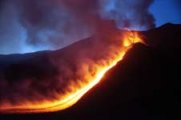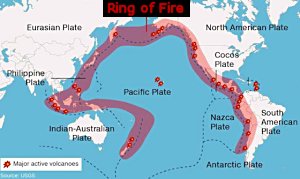
 | What happens to sinking tectonic plates? |
The Earth's surface is made up of large tectonic plates - continental plates, oceanic plates and numerous smaller plates. Powered by massive currents of magma under the crust, these plates are continuously on the move, though at a very slow pace. Some plates move towards each other and others away.
Continental plates are largely composed of igneous rocks rich in the elements that form feldspar and quartz with the most common rocks being granite. Because the continental crust contains largely light minerals such as silica, oxygen aluminium, sodium and potassium, continental tectonic plates are relatively light.
On the other hand, the oceanic crust contains heavier igneous rocks rich in magnesium and iron and most of the ocean floor is composed of basalts. As a result when oceanic plates move towards continental plates, the heavier oceanic plate sinks below the surface of the more buoyant continental plate. This process is called subduction and the boundary where one plate moves below the other is called a subduction zone. Subduction zones are geologically very active, and are the site of many of the world's earthquakes and volcanoes. This video shows the processes which take place at the subduction zone: https://www.youtube.com/watch?v=6wJBOk9xjto
One of the questions which is still poorly understood is what happens to a plate as it submerges into the mantle. One theory proposes that the slab of plate being submerged stays rigid and simply bends due to the forces pulling on the plate. On the other hand there seems to be geophysical evidence that the slabs are simply destroyed by the subduction process. Models of the Earth's interior constructed by scientists using seismic tomography from the western United States revealed anomalies at different depths on their tomographic images. These images indicated that the slabs submerged beneath the Americas may be segmented. The scientists therefore concluded that the slabs in the mantle are strongly deformed and are by no means rigid and immobile. But the discussion is still very much an open topic.
In a newly published study (ref) scientists believe they can provide more answers. They put the subducting tectonic plate through computer generated simulations using different destructive geologic forces. Their computer model showed that as the plate enters the mantle, it bends and cracks appear on the upper side of the plate. As the plate cracks in this way, seawater penetrates the plate through these cracks and is literally sucked in. This weakens the plate on its upper side. But this is only half of the story. T. V. Gerya (the lead author of the publication) and his colleagues believe that as the plate bends, large hard crystals, in particular olivine crystals on the inner side of the plate, are crushed and recrystallized. However, the newly-formed crystals are much smaller and weaker, and this reduces the plate’s resistance, allowing it to bend downwards.
"The results of our simulations are consistent with observations in nature", Gerya explains.

A lot of research has been done along the Japan Trench, where the Pacific plate is sinking below the Okhotsk plate. The pattern of faults found in this region is an exact match for the pattern produced in the simulations. Using a high-resolution seismic tomography model, researchers were also able to show changes to the crystal structure of the plate underside which were in line with what the computer simulation predicted.
"That means our model is very plausible and provides solid physical background for the hypothesis of rigid plates with weak slabs", Gerya says.
Next the scientists used the same simulation but increased the inner Earth temperature to see how the plate would respond in the much hotter conditions of the early Earth. During this simulation the submerging slab was pulled only a few miles into the mantle before breaking off from the main plate. This would suggest that modern plate tectonics are a relatively recent event in the geological history of the Earth, and began only within the past billion years. This final finding is still very much a work in progress, commented Thorsten Becker, a professor in UT's Jackson School of Geosciences at the University of Texas at Austin, Austin, TX, USA, and co-author of this study.
"Personally, I think there are a lot of good arguments for plate tectonics being much older", Becker said, "but the mechanism revealed by our model suggests things might be more sensitive to the temperature of the mantle than we thought, and that, I think, could lead to interesting new avenues of discussion."
Journal Reference:
| _______________________________ | ||||
| Home | | | Shopping | | | Database |
© Biscuit Software 2004-2019
All rights reserved